This is the best homemade gluten-free vegan bread recipe which is egg-free, dairy-free, yeast-free, and nutritious! This German bread is actually healthy since it contains psyllium husk powder. It’s crispy on the outside and soft on the inside!
Homemade Gluten-Free Vegan Bread
I cannot tell you how many times I tried making the perfect gluten-free vegan bread… Actually, I lost count how many times I ended up throwing the towel because it’s damn hard to create good gluten-free bread without eggs.
But since I can be quite stubborn (haha) I actually never gave up and continued with the recipe testing…
Psyllium Husk Powder
One day, I started experimenting with gluten-free pizza crust that contains psyllium husk powder. The recipe turned out so good, that I got intrigued.
To make a long story short, I made an online search about homemade gluten-free vegan bread + psyllium husk and found a couple of different recipes that were using huge amounts of psyllium husk powder in their bread recipes.
One recipe was from a German blogger, and she inspired me to give psyllium husk a try. I tweaked her recipe and used a different flour blend and the bread turned out amazing!
I was shocked by how great it turned out, especially since the bread is wheat-free (and therefore gluten-free), and egg-free (vegan)! It did rise, even though it doesn’t contain yeast and it actually looked like German bread from a bakery.
Conclusion: Psyllium husk powder is a godsend for gluten-free vegan baked goods. It’s also very healthy, especially for our gut! So please do yourself and favor and buy it or order it online. It’s cheap and absolutely amazing!
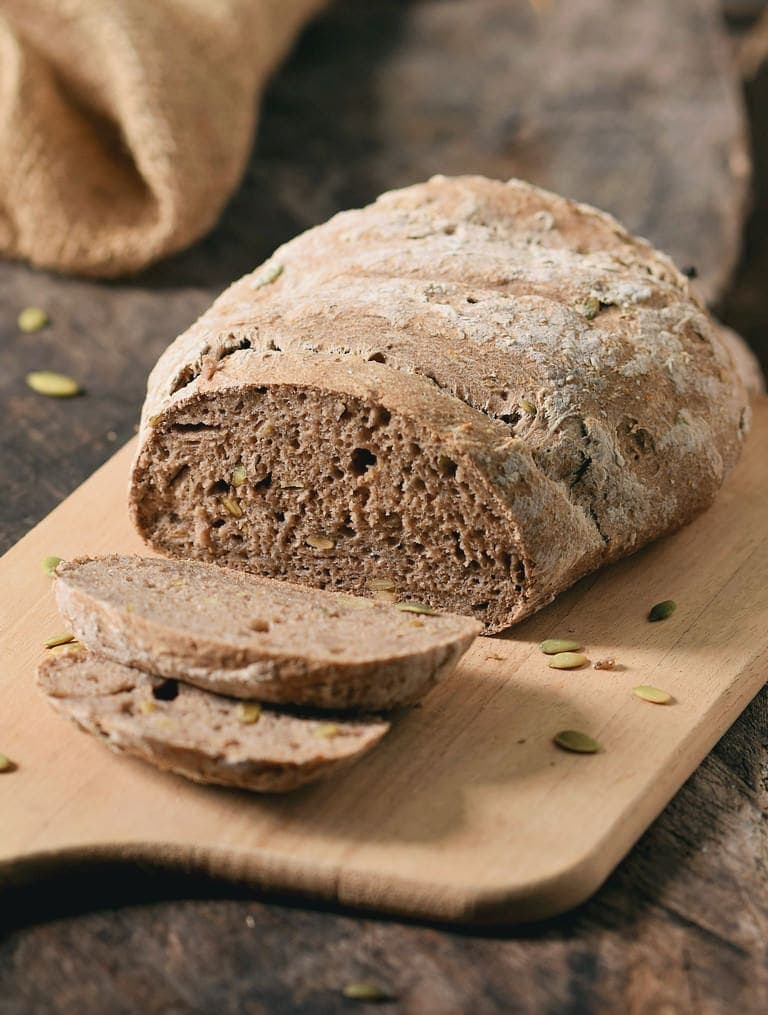
How To Make Gluten-Free Bread?
Check the video in the post to see how I made this amazing bread.
Step 1: Make the psyllium husk gel first. Mix the psyllium husk powder and water in a bowl. Try to be quick, because it gels instantly, within SECONDS. I always use a whisk, it works the best. Set aside and measure the dry bread ingredients in the meantime!
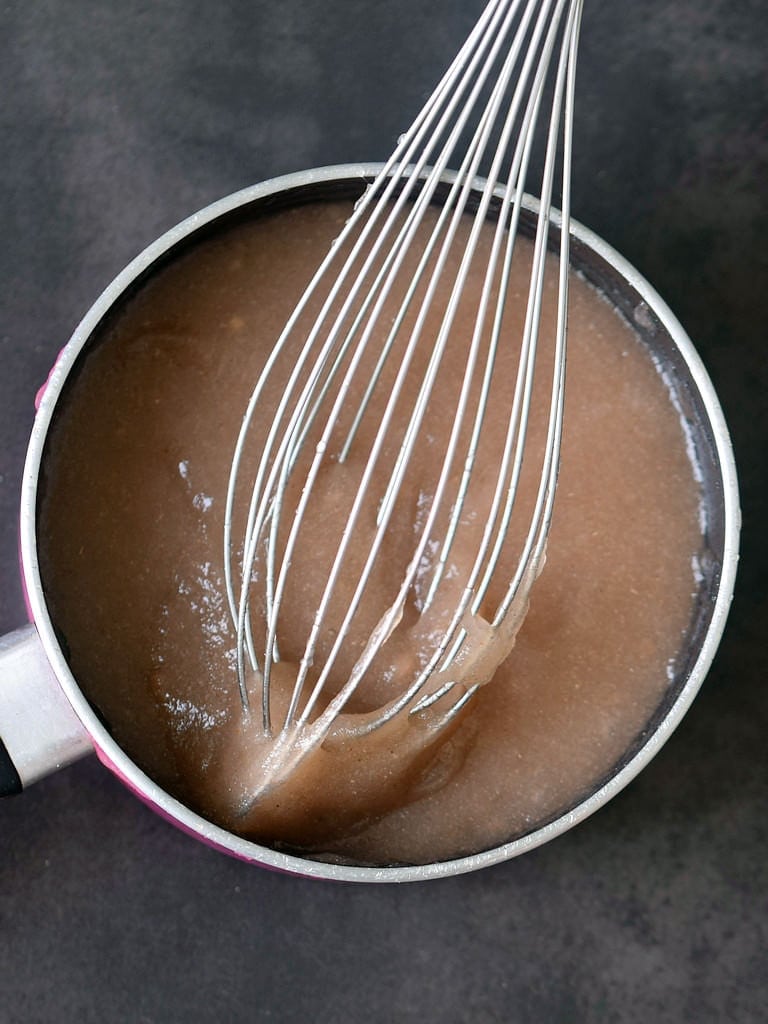
Step 2: It’s time to measure/weigh all dry ingredients and add them to a big bowl. You can also preheat your oven to 390 °F (ca. 200 °C) now.

Step 3: Mix it all together: Add the psyllium gel to the big bowl and mix all ingredients with a hand mixer (use the dough hooks). You can also knead the dough with your hands or use a Kitchen Aid. It will take about 5-10 minutes until the dough comes together.
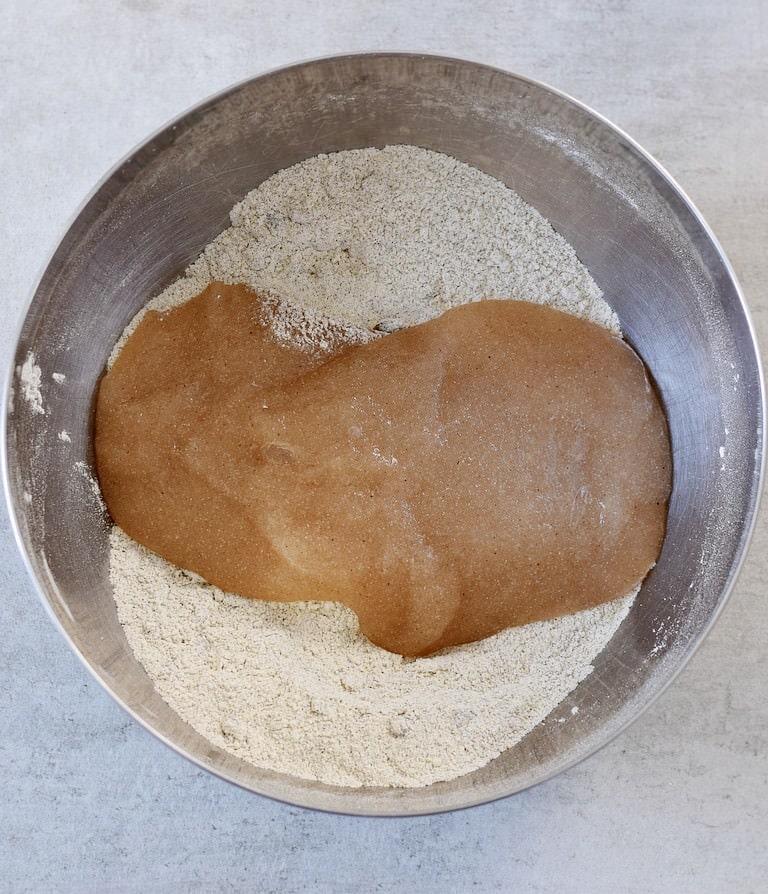
Step 4: Shape the dough and bake the bread in the oven for about 55-60 minutes. That’s it!
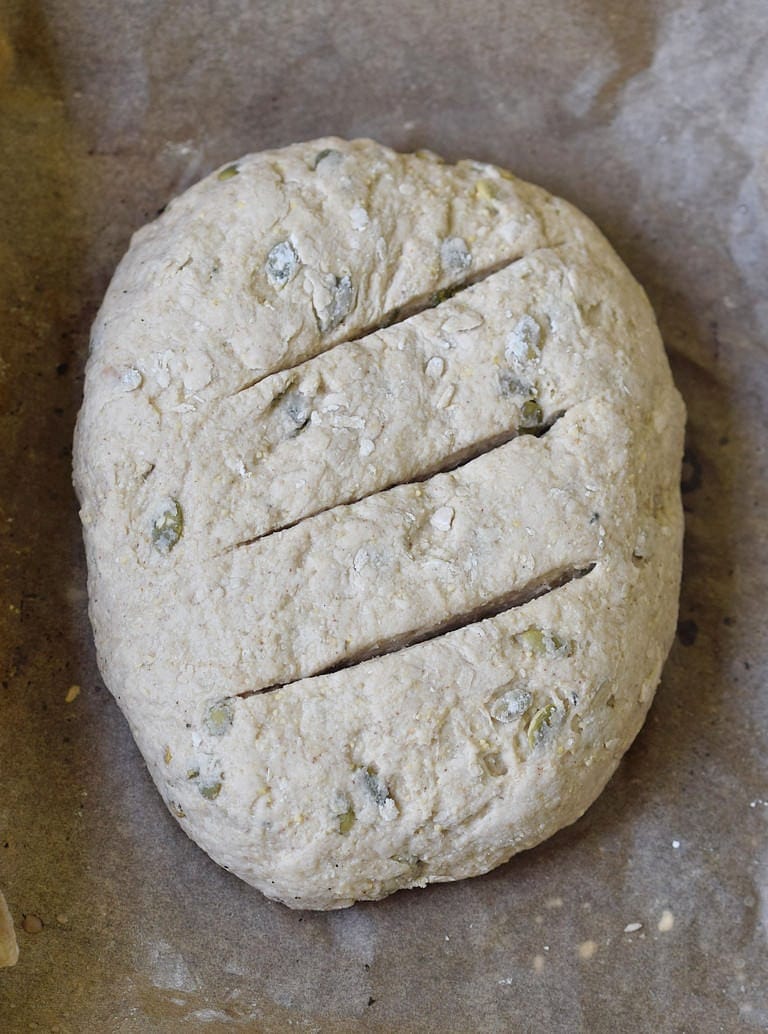
Add Seeds Of Choice
I love adding pumpkin seeds but you can also use sunflower seeds, sesame seeds or nuts of choice (e.g. hazelnuts, walnuts, cashews, almonds, etc).
The Ingredients
You can find all the ingredients with measurements below in the recipe card! Please also check the recipe notes below where I list different substitutes.
My favorite flour combo is this:
- Buckwheat flour
- Rice Flour
- Chickpea Flour
- Tapioca Flour
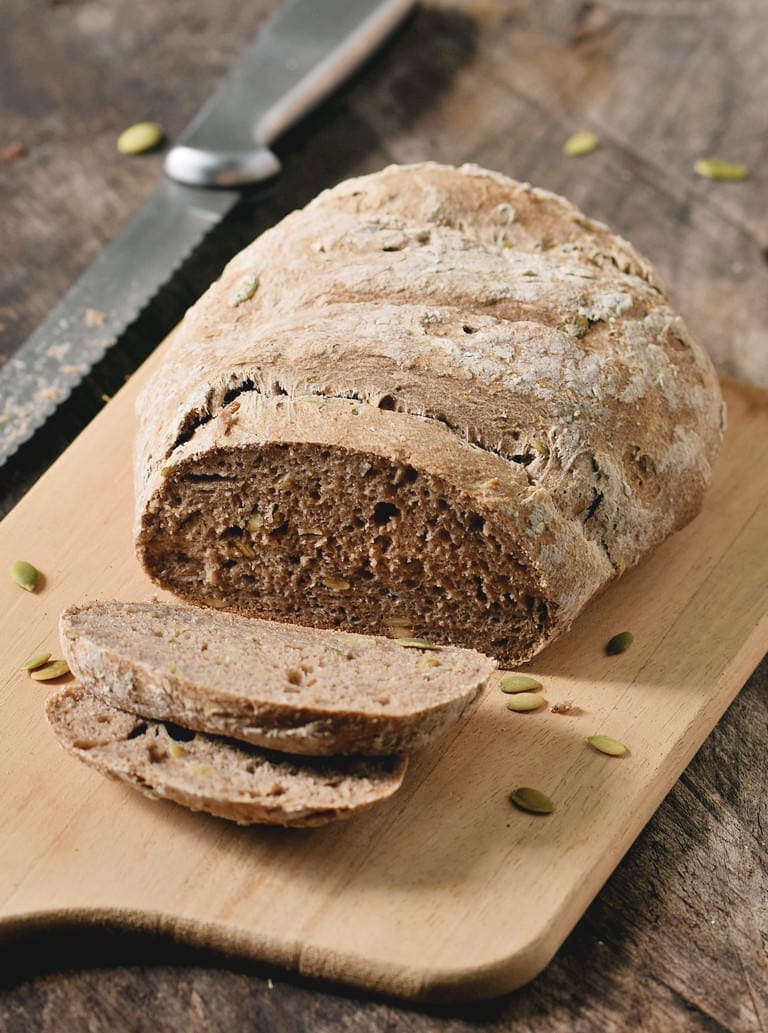
Recipe Notes & Substitutes
- Some readers replaced the buckwheat flour with oat flour or sorghum flour (or a combo) and the bread still turned out amazing.
- Rice flour works great in this bread recipe, but feel free to experiment with lentil flour, teff flour, sorghum flour, or quinoa flour.
- You can use arrowroot flour instead of tapioca flour/starch. Cornstarch or potato starch will most likely work as well.
- Chickpea flour is the same as garbanzo bean flour. It adds plant-based protein and I love adding it to bread. Some readers had success using oat flour instead.
- Psyllium husk powder is the most important ingredient in this recipe and cannot be subbed by any other ingredient. Make sure to use psyllium husk POWDER. If you have psyllium husk (not the powder), you can blend it in a blender or electric spice/coffee grinder until it’s a fine powder.
Can I Freeze Gluten-Free Bread?
You can definitely freeze this gluten-free bread! Slice it and wrap all individual slices in wax paper or parchment paper. Put in zip lock bags and freeze for up to 3 months. Let thaw at room temperature and then toast the bread once you want to serve it.
Other Gluten-Free Bread Recipes
You can serve the bread with stews, soups and all kinds of comfort meals. Make sure to also check out my other vegan and gluten-free bread recipes:
- Gluten-Free Baguette
- Gluten-Free Pita
- Gluten Free Naan
- Gluten Free Buns
- Chocolate Chip Banana Bread
- Pumpkin Bread
- Moist Vegan Cornbread
- Marbled Banana Bread
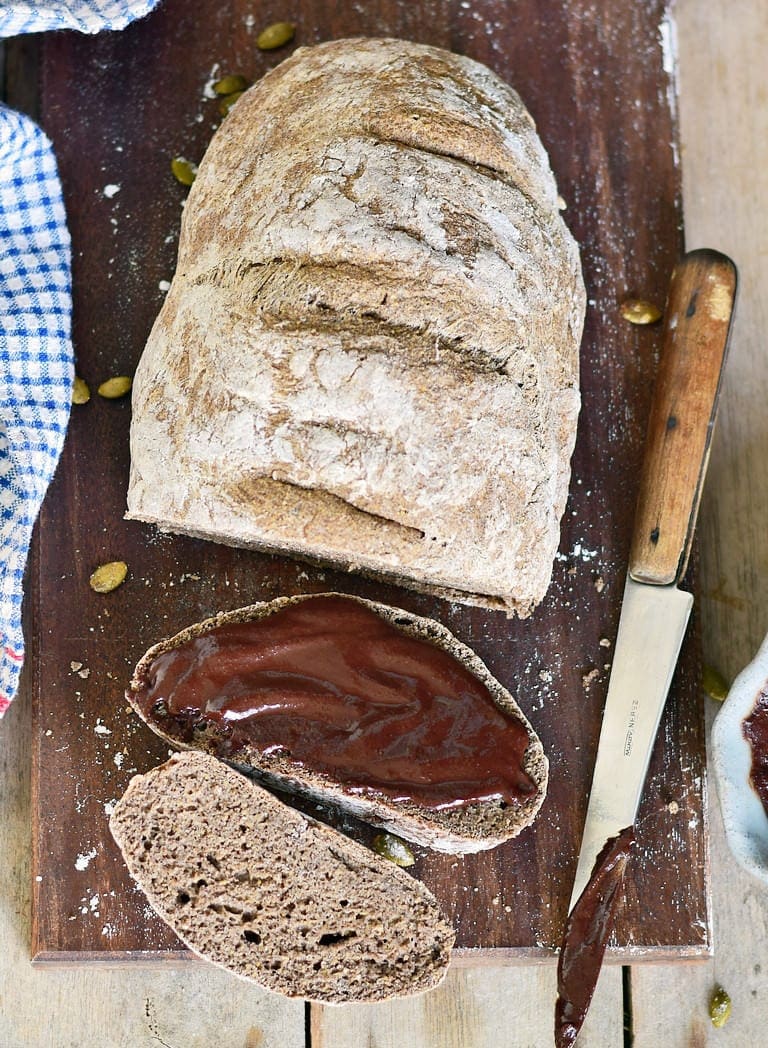
Should you give this gluten-free German bread recipe a try, please leave a comment and rating below and don’t forget to tag me in your Instagram or Facebook post with @elavegan and #elavegan because I love to see your remakes! 🙂
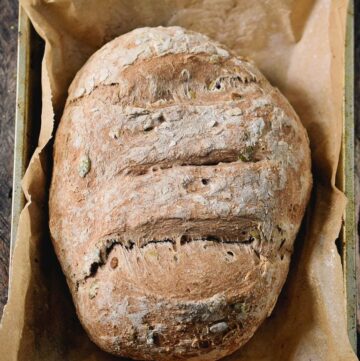
Gluten-Free Bread Recipe
Ingredients
Dry ingredients:
- 100 g (3/4 heaped cup) buckwheat flour (see notes)
- 100 g (2/3 cup) white rice flour
- 100 g (1 cup) chickpea flour
- 40 g (5 Tbsp) tapioca flour/starch (see notes)
- 1 tsp baking powder
- 1/2 tsp baking soda
- 3/4-1 tsp sea salt
- 50 g (3/8 cup) pumpkin seeds (optional - see notes)
Psyllium mixture:
- 450 ml (1.8 cup) water
- 30 g (3 Tbsp) psyllium husk powder (see notes)
Instructions
- I recommend using the metric measurements for this recipe (grams/ml). In a bowl, combine the water with the psyllium husk powder and whisk well. It will gel instantly and become thick. Set aside for 20-30 minutes.
- Meanwhile, measure/weigh all the dry ingredients and add them to a large bowl. Preheat the oven to 390 °F (200 °C).
- Add the psyllium gel to the bowl and knead the ingredients with a hand/ stand mixer (use a dough hook). You can also knead the dough with your hands. It will take about 5-10 minutes for the dough to come together.
- If the dough appears too wet, sprinkle it with 1-2 Tbsp tapioca flour. If it feels too dry, add a little water.
- Shape the dough into a round or rectangular loaf and place it on a baking sheet lined with parchment paper (I sprinkled the paper with a bit of tapioca flour).
- Bake for 50-60 minutes. Let the bread cool completely, then slice and enjoy. The bread freezes well, for up to 3 months!
Notes
Video Of The Recipe
- Psyllium husk powder is the most important ingredient in this recipe and cannot be substituted by any other ingredient. Make sure to use psyllium husk POWDER. If you have whole psyllium husk (not the powder), you can blend it in a blender or electric spice/coffee grinder until it's a fine powder.
- A few people mentioned a weird smell in the bread (I didn't, and most other people didn't either), however, I received a few helpful comments.
- You can use whole-grain buckwheat flour or regular, both are fine. Some people replaced the buckwheat flour with oat flour or sorghum flour (or a combo) and the bread still turned out amazing.
- Rice flour works great in this bread recipe, but feel free to experiment with lentil flour, teff flour, sorghum flour, or quinoa flour.
- You can use arrowroot flour instead of tapioca flour/starch. Cornstarch or potato starch will most likely work as well.
- Chickpea flour is the same as garbanzo bean flour. It adds plant-based protein and I love adding it to bread. Some readers had success using oat flour instead.
- Please don't compare this bread with wheat bread which contains gluten and yeast or a gluten-free bread which was made with eggs and yeast. It's hard to make a gluten-free, yeast-free, vegan bread, but this is the best recipe I have tried so far, and it turns out amazing every time! Depending on the flour mixture, the bread might end up more fluffy or dense.
- Pumpkin seeds: You can use sunflower seeds instead, however, they will turn green due to a chemical reaction with the baking soda/powder. This is perfectly fine and shouldn't concern you.
Nutrition information is an estimate and has been calculated automatically
Equipment
If you are using Pinterest, feel free to pin the following photo:
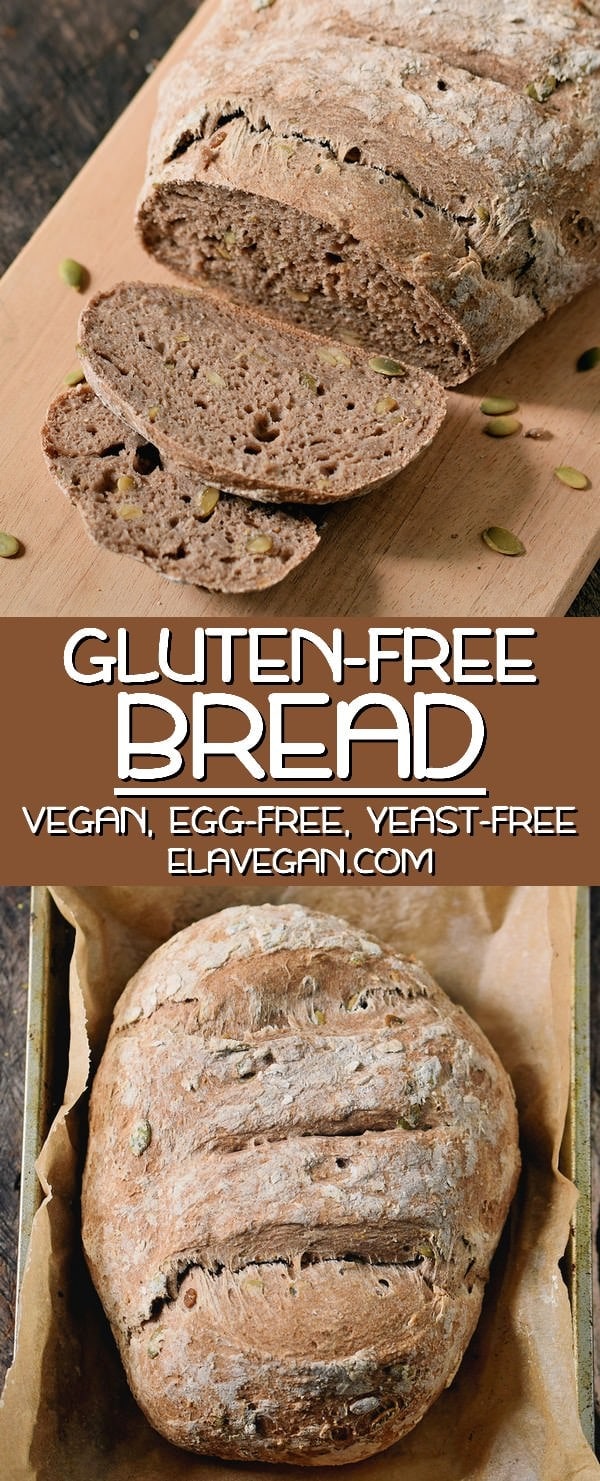

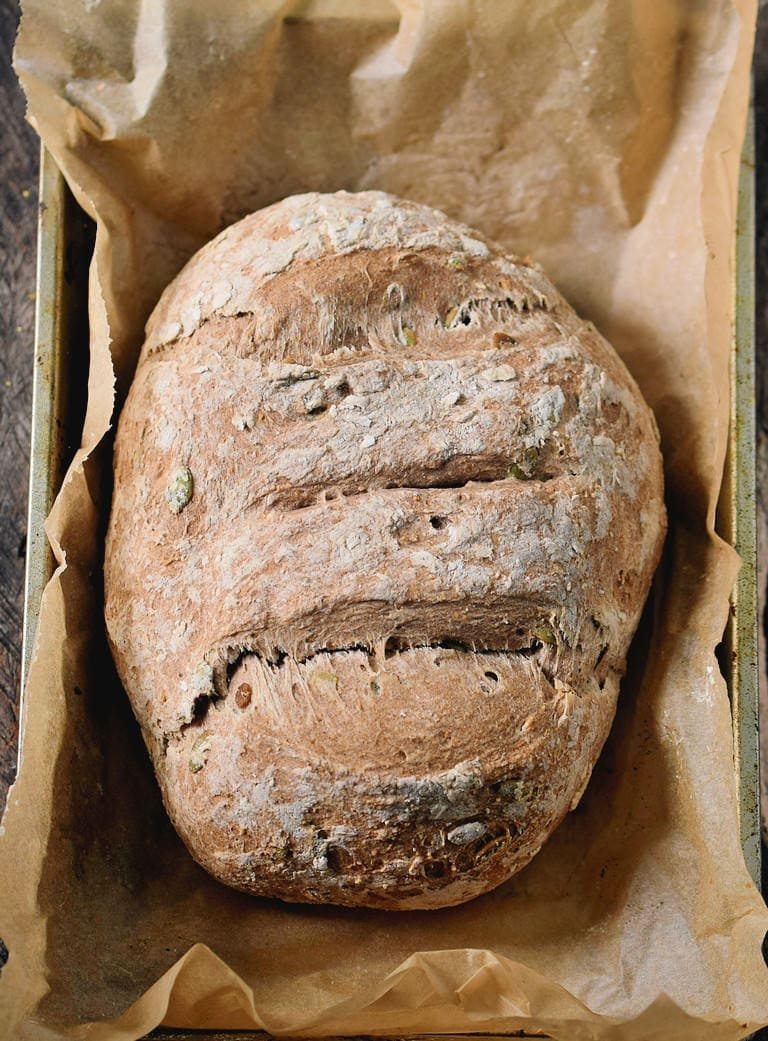
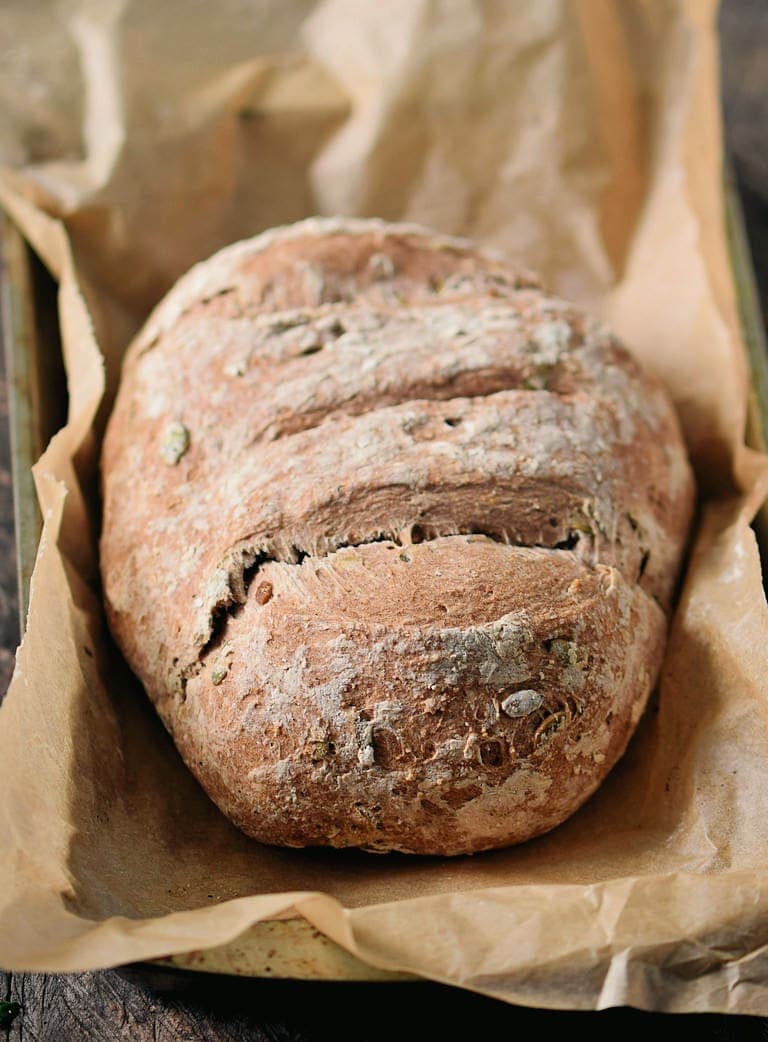
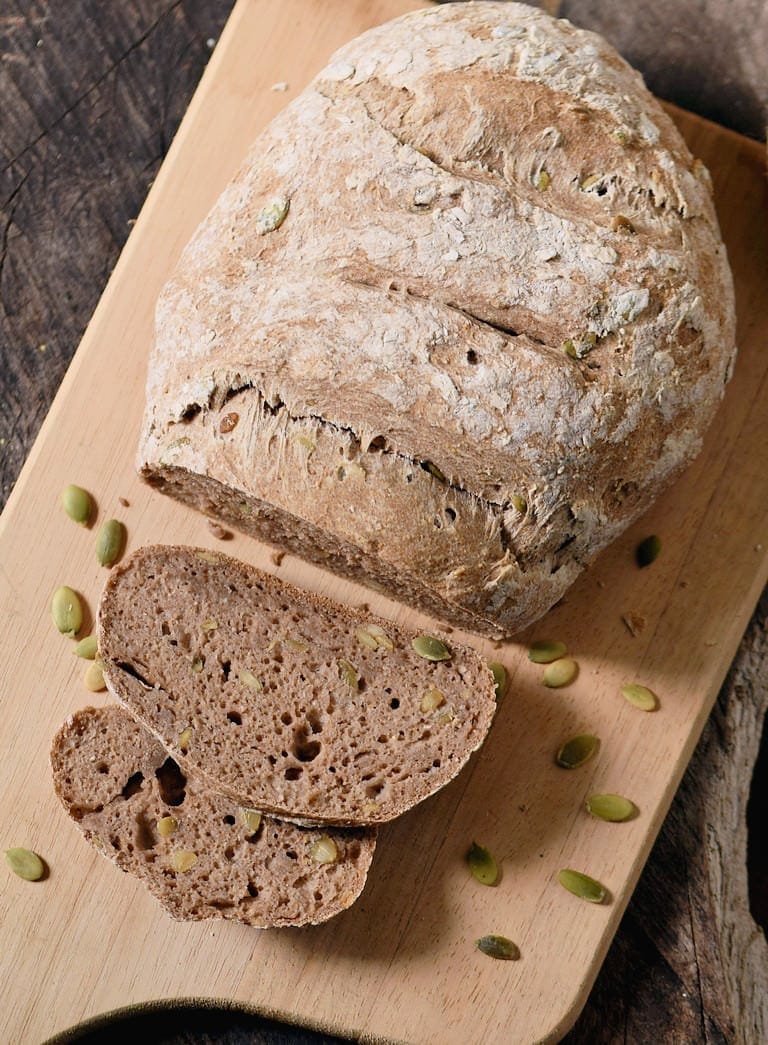
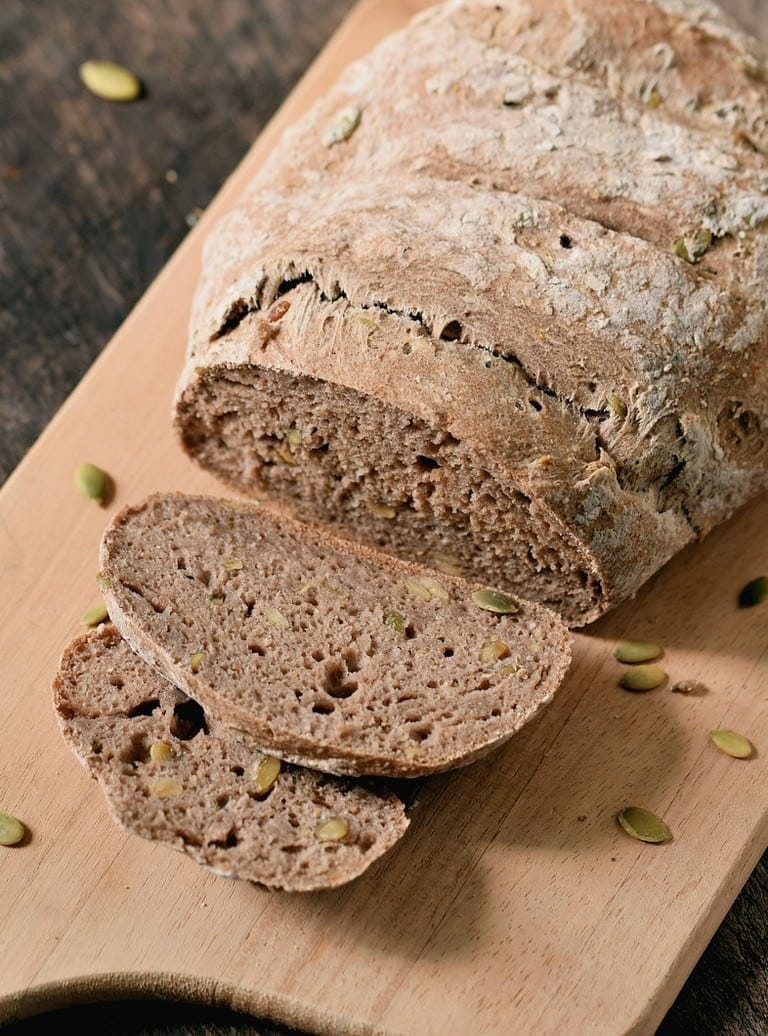
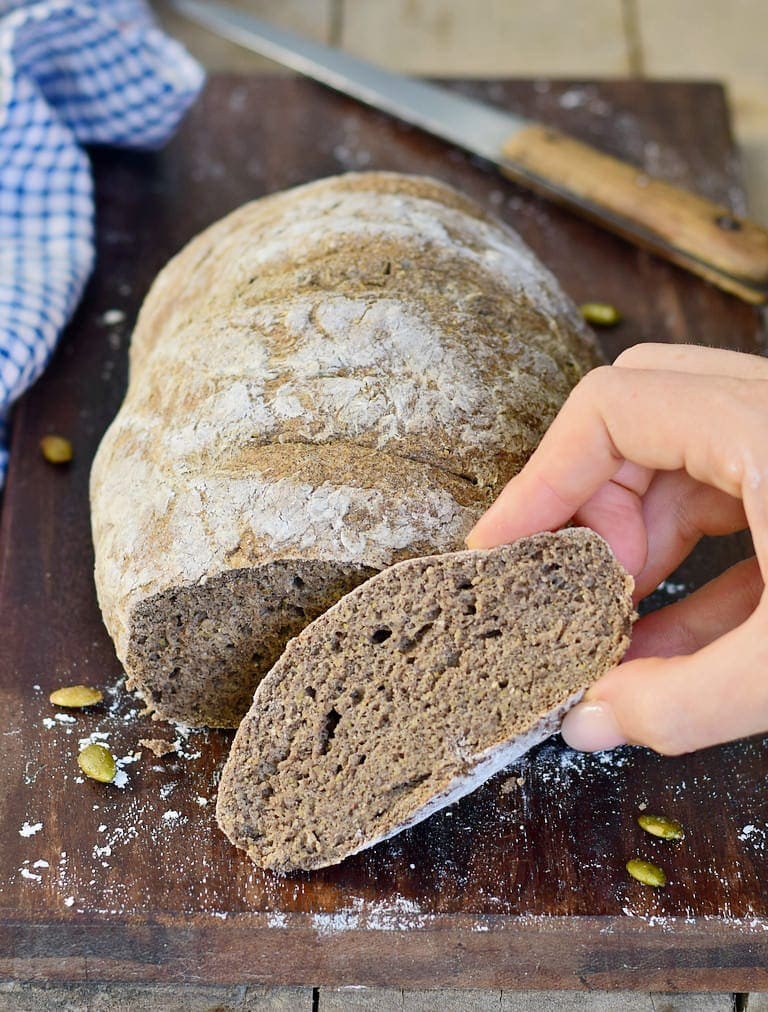
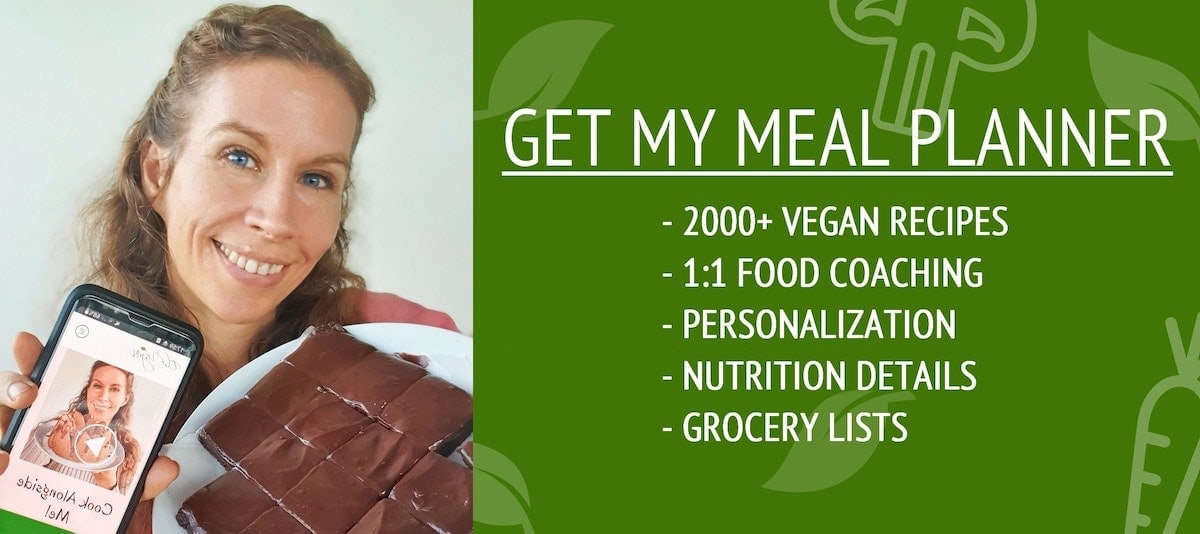
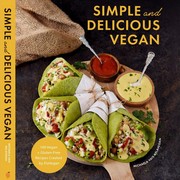
This is excellent! I’ve tried so many gluten-free recipes that have been complete failures! I only had whole psyllium husk so as suggested, I blended them in my Ninja before adding the water and it was perfect! I also didn’t have the exact combo of flours so to make it easy I used 300 g of Bob’s gluten free flour mix (the red bag without gums) and I subbed arrowroot powder for tapioca flour. I was impatient and didn’t wait 20-30 min for the psyllium either, just as long as it took to measure everything else, so a couple minutes. It is PERFECT!!! I was so shocked about the rise and the sponginess of the bread! This was so easy and its amazing! I’ve made so many of your recipes and they are always fantastic! Thank you so much!
You are very welcome, Amanda! So glad it worked with the gluten-free flour mix. 🙂
Thank you for the recipe, I made this today and there was a soggy section along the bottom crust 🙁
The smell people talk about could be the chickpea flour. I reduced the liquid by 1tbsp and added 1tbsp of apple cider vinegar at the dough hook stage.
Maybe next time I’ll try preheating a cast iron skillet before putting the bread on it to bake to possibly fix that raw dough section.
I just finished making this for the second time (this week!). This is the most amazing bread recipe. Easy to do. I definitely recommend using a scale for the ingredients. I ground whole psyllium in my spice grinder to get psyllium powder, used oat flour instead of buckwheat, and left out the sunflower seeds. I don’t have dough hooks, but found it came together just fine by hand (I did need an additional 2 Tbsp tapioca flour, as recommended). 55 minutes in the oven was perfect. Comes out with a decent crust. And this is the first bread I’ve made that actually toasts amazingly (no soggy center while the crust is burning)! Vegan garlic butter on this toasted is perfection. Thank you for this recipe!
You are so welcome, Marissa! Happy you like it. 🙂
Made this for my neighbor who is gf dairy free. My only question is why it’s it purple?
Some psyllium brands may turn the bread a purple shade – don’t worry, this is normal and not a sign of spoilage!
Ela-I’m new to cooking and this is the first and only bread I’ve ever made. Love it and I thank you for it. But! I keep having a problem. The bottom middle of the bread is not cooking through. I’ve played with the cook time and the temp to no avail after 4 attempts. I’m starting to suspect it may have to do with the vessel in which I’m baking the bread. I’ve used a Pyrex 8 X 8 glass pan each time. I’m thinking I should be using a metal pan????? What do you think?
Hi Susan, yes, try a different pan or use no pan at all, as I did. 🙂
I forgot the Baking Soda and Baking Powder! I’m so sad! Its baking now…
It turned out fine! I’m making it again this morning, and I shared this recipe with a friend! Two of my children and my husband all have celiac disease, and I have been trying for three years to find a good recipe! We can’t bring any gluten into the house at all to protect the littles. My hubby still can’t eat this recipe because of its high fiber content, but I can! A few days ago my doctor discovered that I am allergic to wheat, egg, dairy, tomato, and soy, so I was frantic to find something to eat! I’m not supposed to eat any simple carbohydrates, so I switched out the rice flour with oat groat flour. I’m getting set up right now to make my daily batch of bread!
Thanks so much for sharing, Lisa. I am glad it still turned out fine! 🙂
Any ideas what I could replace the tapioca flour with for something more nutritious? If this is going to be a frequent flyer in my house, I’m thinking I better consume less tapioca flour than this.
Lisa, it sounds to me as if your family has what is known as an overgrowth of Yeast problem in the gut, or sometimes called Candida overgrowth. This occurs when there are not enough good flora to keep it under control. Please look online to find and listen to Dr. Eric Bakker of New Zealand explain this condition to you.
I have a friend who is Celiac and got him on to this regime, The Yeast, or Candida turns the inside of the gut into a really sensitive organ which creates multiple allergies and makes your life miserable. I’ve been there and life is now so much easier.
Hi, My first loaf is in the oven and I am so eager to try it! I used a scale so was surprised at how stiff and dry it was so added about 5TB water. I’m here to let you know the video isn’t working properly. I tried watching it several times and halfway through after the second advertisement it just cuts out and goes to a new recipe. I really was hoping to watch your video as bread it not my forte. I was fortunate to have a bag of gluten free chappati flour with a nice blend of flours. I used it for the buckwheat and rice and added the chickpea flour and tapioca to that. I am hopeful! Thanks!
Hi Sue, I hope you will love it! The video works fine, but after about 25 seconds, the player will ask you if you want to continue watching it or skip to the next video (of the playlist). If you do not interact, it will automatically skip to the next video. So make sure to click on “stay”. 🙂
Good morning from Kelwood, Manitoba. Thank you for this recipe. Finally a bread I don’t have to toast. I made exactly as the recipe and really enjoyed it as it was still slightly warm. I look forward to replacing the buckwheat for a milder taste.
Sounds great, Sue! Yes, there are plenty of options to replace it. 🙂
First of all thank you so much for sharing such a wonderful recipe with us, Ela!!! Baked it for the first time today and followed all your instructions. I made a few substitutions – used Buckwheat flour, Rice flour, Oats flour and Arrowroot flour. Reduced water and added 2 tablespoon apple cider vinegar. Very pleased with the final product which looks quite like yours! 🙂
With gratitude and love,
Noopur
That’s fantastic! Thanks so much for sharing. 🙂
Hi Ela, first, I want to thank you for this great recipe. I can’t eat gluten, yeast or buckwheat so I was making rice sour bread but it crust was so firm so it was hard to eat it, so your recipe was a huge discovery for me. On a first try I had a problem with it because the dough was moist tough it didn’t stop me from eating it. 😀 So i try to bake it as I bake wheat bread. I´ve noticed in comments that some of the people had the same problem. I used 150 g integral rice flour, 150 g oat flour, 40 g tapioca, one teespoon apple cider and the rest the same. I baked it for the first 10 minutes on 250 C, and another 40 minutes on 210 C and it came perfectly baked. Next time I will try baking it on a 250 C 25 minutes just to speed up a litlle bit.. Once again thanks!
Thanks for sharing, very interesting! 🙂
I have never baked bread before and I am so tired of spending $7+ per loaf for store-bought vegan GF bread. I followed the instructions exactly using the lesser amount of salt. While I like the texture of this bread the taste is too salty and there is a funk to the smell of the bread. Also, this bread seems to be begging for sweetener of some kind. Any thoughts on adding a little maple syrup or agave or coconut sugar? I am going lessen the salt and try maple in my next loaf and maybe less psyllium (as I think that’s where the “funk” is coming from).
You can definitely use less salt and add some maple syrup or coconut sugar. There were actually a couple of readers who made this recipe like sweet bread with raisins, etc.
A little less psyllium will work, but make sure to reduce the water accordingly.
THIS BREAD RECIPE HAS BECOME OUR FAVORITE GF AND VEGAN BREAD. THANK YOU
You are very welcome! 🙂
Hi there. I’m always looking for a good GF vegan bread recipe, so I tried this. I can’t tolerate chickpeas, so I subbed almond flour. I also rolled the dough ball in a bit of olive oil and baked the loaf in a cast iron 8 1/2 by 4 1/2 in. loaf pan. I baked at 350 F for 60 min until the thermometer read 205 deg F. The result was perfect in terms of crust and texture. In terms of taste …. I could really taste the psyllium powder. Any ideas on cutting that taste? I don’t love it. Use half psyllium powder and half ground flax or chia seeds? Thoughts? Thanks.
Hi Lynn, yes, you could try using half, but then you will also need to reduce the amount of water. Start with 1/2 the amount and add more if needed. 🙂
Hi Ella I don’t like the taste of chickpea flour can it be replaced with maybe oat? and rice flour is too high in carbs for me can you please suggest?
Hi Rosina, you can always experiment with different flours you have on hand. Some people had success with teff flour, quinoa flour, etc. I can only mention the ones I tried myself. 🙂
how much water is used cup wise for the 450ml
That’s 1 7/8 cups. 🙂
thank you, bread is delicious, being on a systemic candida yeast free diet, was treat for me…..
i used 2 pks of stevia with it and would be great to make cinnamin bread also……..thanks again.
Sounds awesome, Patti. So glad you liked it. 🙂
Thank you this recipe. Can’t wait to try. Have you tried using Cassava flour?
Hi Mila, I can’t buy Cassava flour here, so I haven’t tried it. It might work, though. 🙂
Have you by chance tried this in a bread maker?
I haven’t, but a couple of readers did with success. You can read through the comments. 🙂
Hi Ela! Thank you for this recipe. I am going to make it tomorrow. I was thinking of adding a bit of salt for added taste. Will this effect the recipe?
Hi Rima, the recipe already contains 3/4-1 tsp of salt. 🙂
I desperately want to make this recipe. I’m in the US but I will measure everything in grams. I noticed the original recipe and the US cup recipe has different gram amounts. Which one should I use?
It is always best to use the metric measurements as written in the recipe. In the recipe notes, I have converted the grams into cups, however, some cup numbers came out crooked (like 0.625 cups), so I have rounded the cup numbers and thus the grams differ slightly. But that doesn’t matter, because the total amount in grams is almost the same. The bread can be made with so many different flours and usually still turns out well. Therefore, it doesn’t matter if you use 10-20 grams more or less of one type of flour, as long as the total amount in grams stays the same (340 grams). I hope this helps. 🙂
I just tried this recipe because I wanted to give a treat to a couple friends who are unable to eat bread that contains gluten or wheat. It is literally cooling right now and looks amazing. It also smells delicious.
Hi CeCe, I am so glad it turned out great. 🙂
This is only my second recipe in to make gluten free bread, and this recipe really worked on my first try! It’s amazing what psyllium husk powder does What I especially like about this recipe is the whole grain aspect, as well as being able to adapt to the flours I have on hand. Besides it really is spongy, very much like wheat and yeast breads. I couldn’t be more pleased.
I used oat flour in place of the buckwheat, quinoa flour in place of the rice flour, and Krusteaz All-Purpose Gluten-free flour for the chickpea flour. Wonderful loaf! Thanks for posting your recipe and including all the helpful notes. This is a keeper.
Any suggestions where to buy bulk psyllium husk powder?
That’s wonderful, Alexandra, so happy you love it. Thanks for sharing your substitutes.
I am not sure where you are based, but maybe try Wholefoods or Amazon. 🙂
In the US you can buy psyllium at CVS or Walgreens and at Wholefoods
That’s awesome, Sarah! Thanks for sharing 🙂